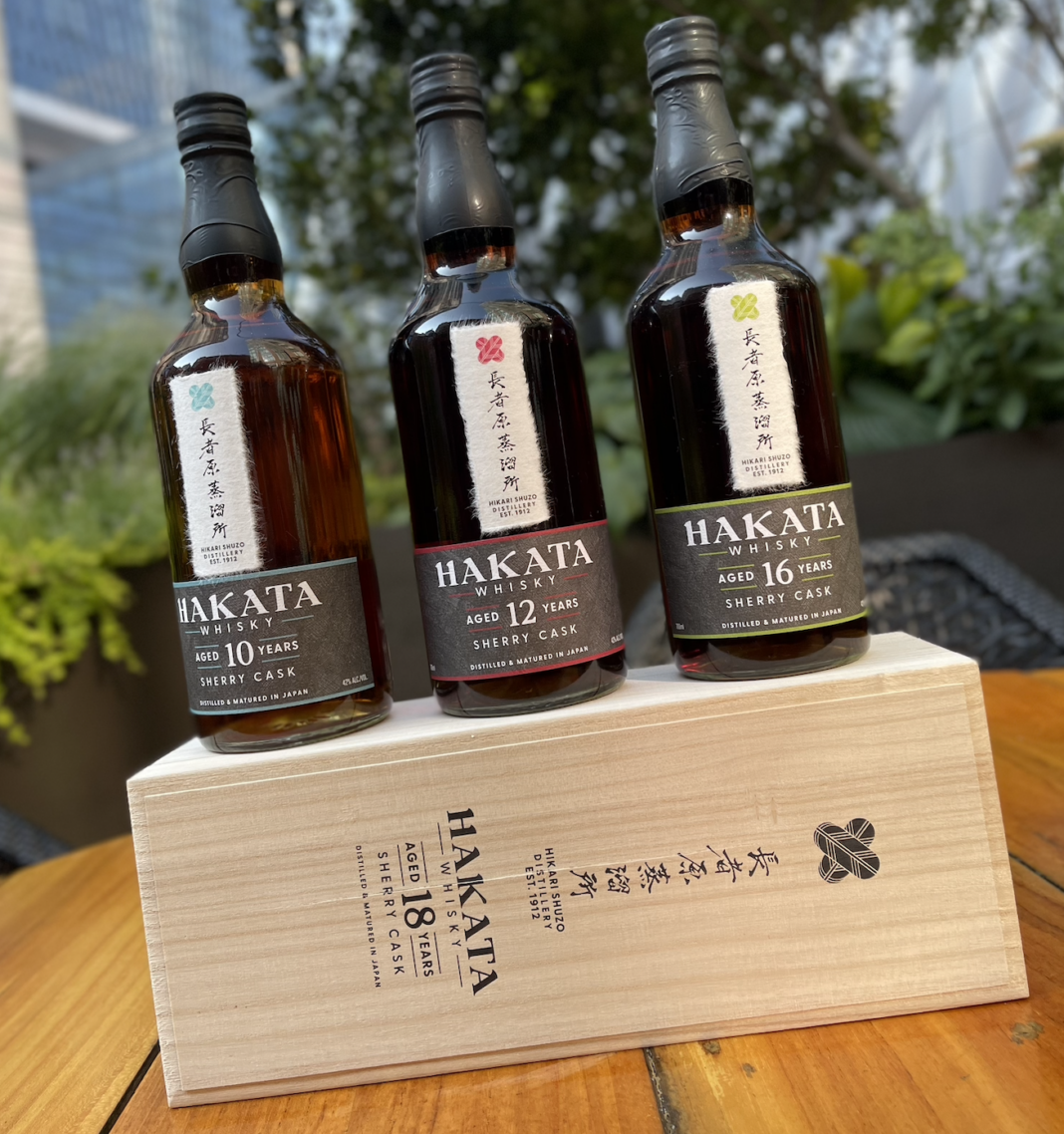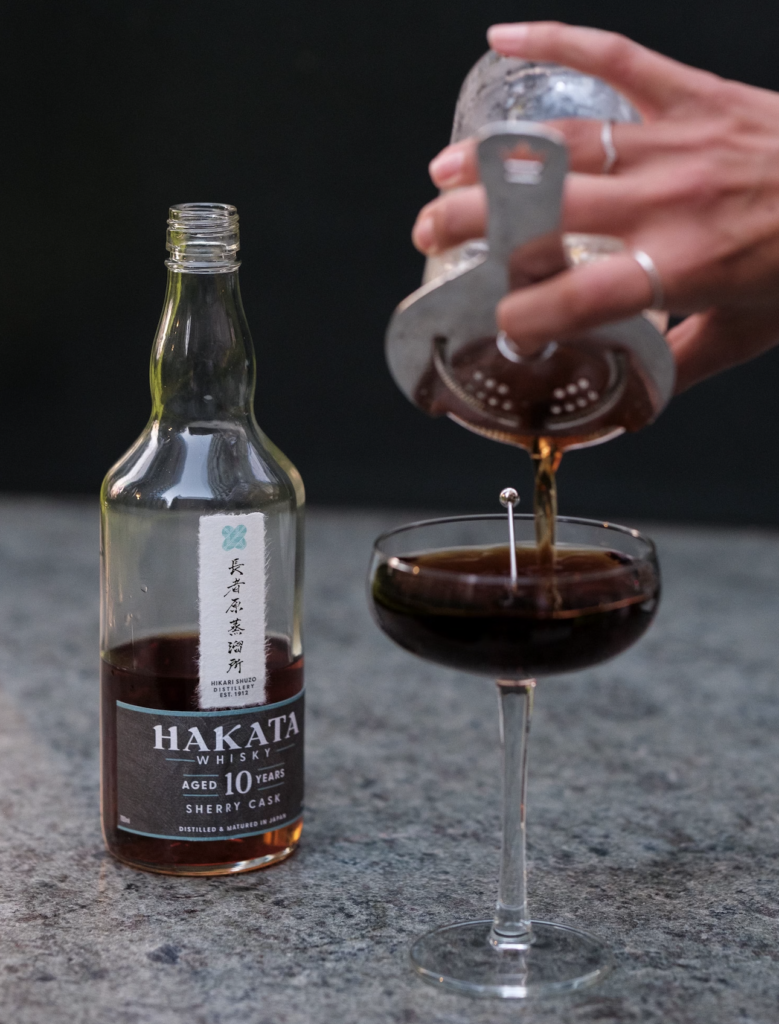
When I write “whiskey,” what are the first three things that come to your mind?
Here’s what comes to mine: The South (specifically: Kentucky and Tennessee), grains (specifically: barley, wheat, and rye), and Don Draper (specifically: any time the camera cuts to him).
For the American whiskey drinker (noob to expert), I’d guess that at least one of my stereotypes line-up.
Boring.
Time to learn something different, and start the Fall with new information and flavors other than pumpkin spice.
Enter: Japanese Whisky. Note: It’s even spelled without the “e!” (We will learn why later.)
I took a deep dive into the Hakata Whisky catalog, which includes premium whiskies, distilled and matured in Fukuoka, Japan, that hit U.S. markets for the first time this year.
A new swath of spirits AND a different country of origin…we are already stepping outside the box!
Now, time to learn something new! Thankfully, Chris Uhde, the Vice President of ImpEx Beverages had some time to chat.
(ImpEx is the importer of Hakata Whisky, and the project is a collaboration between ImpEx and the Hikari distillery in Fukuoka. That means it’s essentially a co-op and ownership of the brand is shared between the two companies.)
Emily: Let’s start with the basics: spelling: whiskey v whisky – why don’t Japanese whiskies have an “e” like their American “whiskey” counterparts?
Chris Uhde: The spelling of Scotch whisky (no ‘e’) is enshrined in law. The same applies to Canadian whisky, while Japan, England, Wales, the Nordics, Australia follow suit. American and Irish producers primarily use the alternate spelling, with the ‘e’. While I am not 100% certain, I would guess that it is because when the Japanese initially adopted the use of the word whisky, they did so from a scotch whisky perspective which would not have had the (e). Scotland is where the first Japanese Malt Whisky distiller went to train.
Emily: Let’s expand on the differences, what makes a Japanese whisky different from an American whiskey?
Chris: Think of an American whisky as a triangle, and the Japanese Whisky as a sphere. The American triangle has sharp edges which represent the intense oak, big corn, and classic sweetness. The Japanese Sphere doesn’t have the same edges as it is built outward from the center – with some sweetness, some savoriness, some oak, some grain etc.- layers. Ironically enough, Hakata is a bit of an outlier in this analogy as it does have a very big sherry cask influence. One would expect it to be mellow and centered, when actually it’s dialed up to 11 with intensity of aroma and flavor.
Emily: For those who enjoy the occasional (or frequent) glass of Kentucky Bourbon, which expression of Hakata would you have them try as an entryway to a Japanese Whisky and why?
Chris: I would recommend that the Kentucky bourbon enthusiast / drinker start with the Hakata 10 Years Old. It’s affordable and beautifully demonstrates the signature backbone and foundation of the Hakata style. It’s also incredibly approachable through the notes of sweetness and classic oak. From there, I would suggest trying the super-refined Hakata 16-Year-Old Whisky, which was honored with an outstanding 96 points by Whisky Advocate this year – a score achieved by only seven other whiskies in the past decade.
Emily: Let’s expand on that! For those who are Japanese Whisky drinkers – what’s your pitch to get them to try this brand and what really sets it apart?
Chris: Hakata is a singular and unparalleled experience. There is no other whisky in Japan, or even on the planet that tastes the same. The flavors that Hakata delivers are unique unto themself – from the intensity of the Umami to the savory sherry influence on the spirit. With only 1,000 casks currently in existence, it is something to be enjoyed now, and is intended to be memorable in the future.
Emily: Now we are getting into some “umami” territory where I am a noob, because you’re talking about ingredients in the whisky that are not really found in American whiskeys. Hakata is fermented with koji. First – to a fifth grader – what is koji and where do we find it?
Chris: Think of koji as the magical ingredient or “magic mold”! Used for centuries and hailed as Japan’s “national fungus,” koji is a mold that plays a foundational role in much of the country’s traditional cuisine, including the production of alcoholic beverages like sake or shōchū, and condiments like miso, mirin, and soy sauce. The enzymes present in koji molds transform starches and proteins into amino acids and sugars. The resulting flavors define the realm of umami: sweet, savory, salty, with an undertone of pleasing funk.
Hakata Whisky is distilled and matured in Japan using 100% barley, a fraction of which is fermented with Koji – providing healthy enzymes for fermentation, and thus delivering a savory, unmistakable, Umami-enhanced patina. This naturally occurring culture is particularly prevalent in Japan, where it is known as koji-kin.
Emily: So to really beat a dead bear and to get this into my head: Why does the koji make Hakata’s spirits unique?
Chris: Umami is a flavor typically more associated with food than spirits. The koji is unique because it adds both Umami and a really nice breeding environment for yeast. Koji gives amylase (a special enzyme/protein that helps digest carbohydrates) for healthy fermentation, but it also helps to keep acidity high enough in the ferment where other undesirable microbes are not able to thrive, giving the yeast a competitive edge and giving the distiller a good base to distill from.
Emily: Now, I can woman-splain this to anyone. THANK YOU! Moving on: Let’s talk about the “where.” When you talk about the Hikari Distillery (where the whiskies are produced), why is it so storied?
Chris: I think a lot of westerners don’t truly realize how much of a small family business some of these distilleries are. For example, the family actually still lives on the grounds of the distillery. The sales office is in the front, with the living space in the middle building, and the distillery behind that. It’s almost like having a distillery in your backyard.
Also, the sherry casks that Hakata are aged in were an impulse project. The former president of the distillery took a trip to Spain, and while he was there he fell in love with sherry – so he bought some empty casks when he got back to Japan to experiment with. We are lucky to even have the product as had he not taken that trip, there would not have been any casks for us to enjoy now.
Lastly, Hakata employs a type of distillation that is ancient and has been leveraged by some of the finest distillers in Japan for nearly 500 years.
Emily: Now, for everyone’s favorite part – the taste! What was your reaction when you tasted Hakata Whisky for the first time and which one was it?
Chris: That would be the Hakata 18 Years Old Sherry. I was truly surprised at its intensity! An over-the-top explosion of Umami and sherry cask in the flavor profile. Unlike anything I’d. tried before.
Emily: What are the mash bills of the Hakata 18, 16, 12, and 10?
Chris: All of the Hakatas are made with ⅓ Koji Barley and ⅔ Unmalted barley. The ⅓ Koji
barley is the portion that provides the good enzymes for healthy fermentation.
Emily: What is the key difference between the 18 and the 16 Year Old? Is it just the 16 with two extra years in the cask? Or is there a difference in the blend?
Chris: The 16 year old is primarily 2nd fill Sherry casks, while the 18yr is almost all 1st fill. Sherry Casks. For context, whisky is aged in oak casks that have a lifetime of about seven decades, meaning a barrel is used more than once. A barrel the first time used is referred to as the first fill. There’s a 12-year aging period before the cask is emptied and filled with new make spirit for a second time, referred to as a second fill. The fill is a significant factor in the flavor profile, too. Casks are used to age bourbon or sherry historically, and different types of casks contribute to different flavor profiles in a maturing malt whisky. Bourbon barrels impart a light sweetness, while sherry casks lend a more profound sweetness with a range of fruit cake and dried fruit notes.
Emily: Are the casks for all of the years just Sherry Casks or have they previously been some other spirit’s cask?
Chris: All expressions in the Hakata whisky portfolio are matured in Sherry Casks. The 10 Year Old and 16 Year Old had spirits aging in them for 2 full years way back when, thus making them 2nd fill casks.
Emily: Is there a cocktail for the 10 or 12 years that you’ve tried, and you think makes the flavors sing?
Chris: Yes, it’s named “Summer in Hakata”, created by the very talented Linh Do (@arthousewhisky)

Recipe:
2 oz Hakata 10yr
.75 oz Fresh Lime Juice
.75 oz Spiced Rainer’s cherry Syrup
.25 oz Demerara Syrup
.25 oz Geijer California Orange Liqueur
+ Chocolate Bitters
Steps:
-Combine ingredients and shake vigorously in a cocktail shaker, pour over ice and serve in a coup glass.
Emily: Linh Do’s cocktail inspired me to ask about other drinks to try with some of these expressions. I reached out to top New York City bartender Ana Paula Moraes and here’s what she came up with after tasting the Hakata whiskies.

“Hakata meets Manhattan” created by @anapaularibmoraes
3 oz Hakata 10yr
1 oz coffee liqueur
2 dashes of chocolate bitters
2 dashes Angostura bitters
Steps:
-Stir everything in a mixing glass with ice. (45 stirs or about the time it takes you to sing the chorus to your favorite song!) Pour into coup glass and garnish with a black cherry. Savor and enjoy!
“Umami’d Old Fashioned” created by @anapaularibmoraes
(Author note: Instead of the sweetness that you get with a traditional Old Fashioned, this cocktail finishes with a deep spice that would impress even Don Draper.)
Recipe:
2oz Hakata 12yr butter washed
.25 oz homemade spiced vanilla syrup
2 dashes Angoustura bitters
2 dashes chocolate bitters
Steps:
-Stir all ingredients together in a mixing glass with ice. Serve into a double rocks glass with a big ice cube. Garnish with orange peel. Savor and (optional, create a prolific marketing ad in the style of Mr. Draper).

Emily: I noticed that the colors for the 10 and 16 are similar, and so are the tastes? Is there a reason for that?
Chris: Yes! Both the 10 Years Old and the 16 Years Old have some 2nd fill casks in the vatting, or the storage period.
Emily: Similarly, I noticed that the colors for the 12 and 18 are similar, and so are the tastes? Is there a reason for that?
Chris: You’re correct! Yes, for the same reason as noted before, those are primarily first fill sherry casks.
Emily: Can you explain the intense woody aftertaste of the 12 and 18? Why is it not as prominent in the 10 and 16?
Chris: The simplest way to explain this is the percentage of first fill vs. second fill casks across the different expressions. It’s true that the 12 year old is truly oak and umami defined – an enchanting, balanced whisky. The 18 Years old envelopes an intensity of aromas does include, amongst other references – wood spices, dark soy sauce, and worn-leather.
Emily: What is your ideal way to drink each expression? Neat? With water? Big ice cube?
Chris: We recommend enjoying Hakata neat, served in a classic tulip glass. Tulip glasses are fantastic for sampling whiskey, because the wide, round base allows the aromas of the whiskey to collect, while its tulip-shaped mouth captures and directs the aroma to the nose for enhanced tasting experience.
Emily: What’s a fun fact about Hakata Whisky that we can’t read on the back of the bottle?
Chris: One of the coolest things about Hakata is that some of the casks are matured outside in open-air with nothing but an awning covering them. Being exposed to the humidity and heat causes the casks to expand and contract like an accordian which really gives intensity of flavor from the cask. Another fun fact is that Hakata is still distilled in a stainless steel pot still, which is really not common in whisky.
Emily: What’s your hope for Hakata in the next 5 years?
Chris: Our hope is for Hakata to be loved and enjoyed just like all of the other great whiskies in the world. New to the U.S market, this is a premium whisky that appeals to both seasoned and sophisticated drinkers but is also approachable enough for casual whisky and bourbon enthusiasts. We hope that it invites a new audience who have the opportunity to experience how elegant and diverse whisky can be and to expand their palate.







